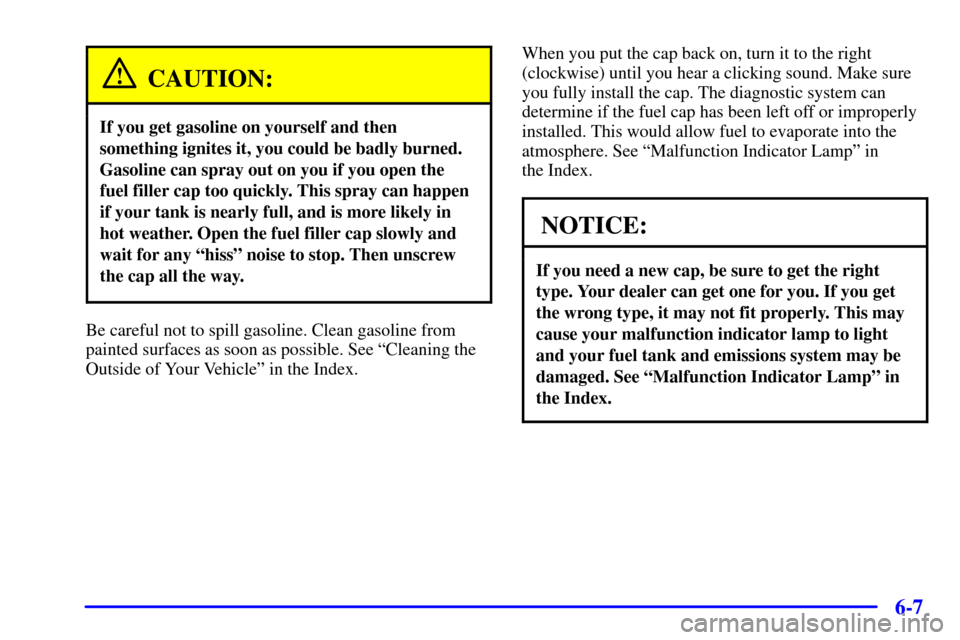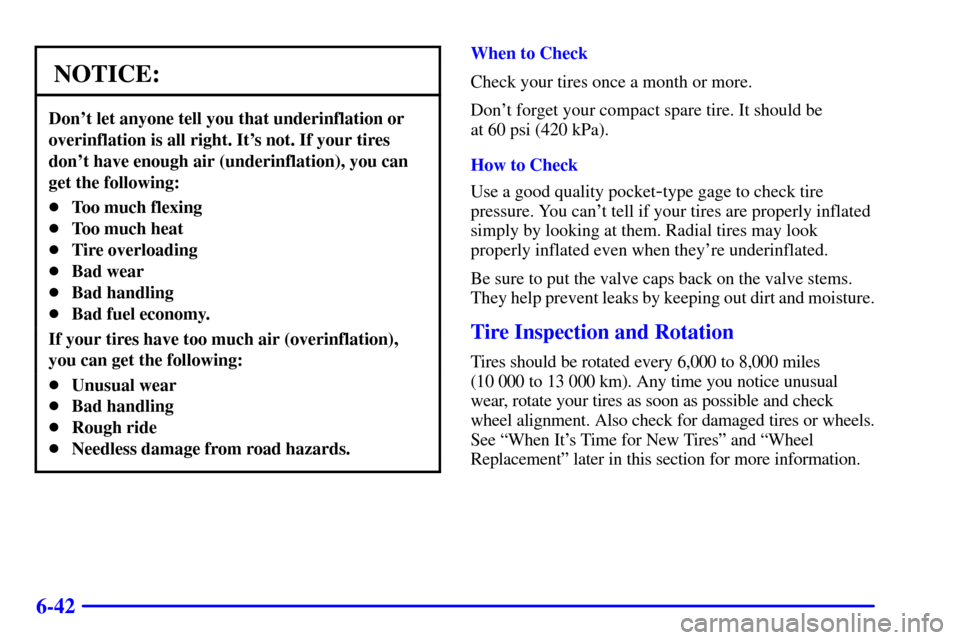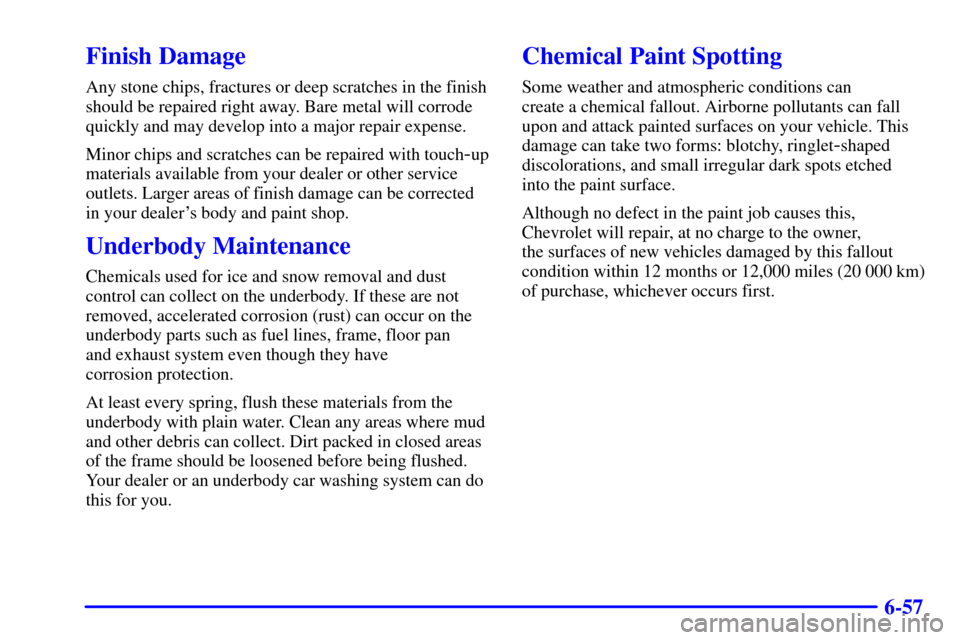Page 257 of 357
6-6
Filling Your Tank
CAUTION:
Gasoline vapor is highly flammable. It burns
violently, and that can cause very bad injuries.
Don't smoke if you're near gasoline or refueling
your vehicle. Keep sparks, flames and smoking
materials away from gasoline.
The cap is located behind a hinged door on the driver's
side of your vehicle.
While refueling, hang the cap by the tether from the
hook on the filler door.
To remove the cap, turn it slowly to the left
(counterclockwise). The cap has a spring in it; if you let
go of the cap too soon, it will spring back to the right.
Page 258 of 357

6-7
CAUTION:
If you get gasoline on yourself and then
something ignites it, you could be badly burned.
Gasoline can spray out on you if you open the
fuel filler cap too quickly. This spray can happen
if your tank is nearly full, and is more likely in
hot weather. Open the fuel filler cap slowly and
wait for any ªhissº noise to stop. Then unscrew
the cap all the way.
Be careful not to spill gasoline. Clean gasoline from
painted surfaces as soon as possible. See ªCleaning the
Outside of Your Vehicleº in the Index.When you put the cap back on, turn it to the right
(clockwise) until you hear a clicking sound. Make sure
you fully install the cap. The diagnostic system can
determine if the fuel cap has been left off or improperly
installed. This would allow fuel to evaporate into the
atmosphere. See ªMalfunction Indicator Lampº in
the Index.
NOTICE:
If you need a new cap, be sure to get the right
type. Your dealer can get one for you. If you get
the wrong type, it may not fit properly. This may
cause your malfunction indicator lamp to light
and your fuel tank and emissions system may be
damaged. See ªMalfunction Indicator Lampº in
the Index.
Page 259 of 357

6-8
Filling a Portable Fuel Container
CAUTION:
Never fill a portable fuel container while it is in
your vehicle. Static electricity discharge from the
container can ignite the gasoline vapor. You can
be badly burned and your vehicle damaged if this
occurs. To help avoid injury to you and others:
�Dispense gasoline only into
approved containers.
�Do not fill a container while it is inside a
vehicle, in a vehicle's trunk, pickup bed or
on any surface other than the ground.
�Bring the fill nozzle in contact with the
inside of the fill opening before operating
the nozzle. Contact should be maintained
until the filling is complete.
�Don't smoke while pumping gasoline.
Checking Things Under the Hood
CAUTION:
An electric fan under the hood can start up and
injure you even when the engine is not running.
Keep hands, clothing and tools away from any
underhood electric fan.
CAUTION:
Things that burn can get on hot engine parts and
start a fire. These include liquids like gasoline,
oil, coolant, brake fluid, windshield washer and
other fluids, and plastic or rubber. You or others
could be burned. Be careful not to drop or spill
things that will burn onto a hot engine.
Page 263 of 357
6-12
Before closing the hood, be sure all the filler caps are on.
Then pull the hood down and close it firmly.
Engine Oil
If the LOW OIL light
appears on the instrument
panel, it means you need
to check your engine oil
level right away. For more
information, see ªLow Oil
Lightº in the Index.
You should check your engine oil level regularly; this is
an added reminder.
Checking Engine Oil
It's a good idea to check your engine oil every time you
get fuel. In order to get an accurate reading, the oil must
be warm and the vehicle must be on level ground.
The engine oil dipstick is the yellow loop located near
the back of the engine.
Page 293 of 357

6-42
NOTICE:
Don't let anyone tell you that underinflation or
overinflation is all right. It's not. If your tires
don't have enough air (underinflation), you can
get the following:
�Too much flexing
�Too much heat
�Tire overloading
�Bad wear
�Bad handling
�Bad fuel economy.
If your tires have too much air (overinflation),
you can get the following:
�Unusual wear
�Bad handling
�Rough ride
�Needless damage from road hazards.
When to Check
Check your tires once a month or more.
Don't forget your compact spare tire. It should be
at 60 psi (420 kPa).
How to Check
Use a good quality pocket
-type gage to check tire
pressure. You can't tell if your tires are properly inflated
simply by looking at them. Radial tires may look
properly inflated even when they're underinflated.
Be sure to put the valve caps back on the valve stems.
They help prevent leaks by keeping out dirt and moisture.
Tire Inspection and Rotation
Tires should be rotated every 6,000 to 8,000 miles
(10 000 to 13 000 km). Any time you notice unusual
wear, rotate your tires as soon as possible and check
wheel alignment. Also check for damaged tires or wheels.
See ªWhen It's Time for New Tiresº and ªWheel
Replacementº later in this section for more information.
Page 308 of 357

6-57
Finish Damage
Any stone chips, fractures or deep scratches in the finish
should be repaired right away. Bare metal will corrode
quickly and may develop into a major repair expense.
Minor chips and scratches can be repaired with touch
-up
materials available from your dealer or other service
outlets. Larger areas of finish damage can be corrected
in your dealer's body and paint shop.
Underbody Maintenance
Chemicals used for ice and snow removal and dust
control can collect on the underbody. If these are not
removed, accelerated corrosion (rust) can occur on the
underbody parts such as fuel lines, frame, floor pan
and exhaust system even though they have
corrosion protection.
At least every spring, flush these materials from the
underbody with plain water. Clean any areas where mud
and other debris can collect. Dirt packed in closed areas
of the frame should be loosened before being flushed.
Your dealer or an underbody car washing system can do
this for you.
Chemical Paint Spotting
Some weather and atmospheric conditions can
create a chemical fallout. Airborne pollutants can fall
upon and attack painted surfaces on your vehicle. This
damage can take two forms: blotchy, ringlet
-shaped
discolorations, and small irregular dark spots etched
into the paint surface.
Although no defect in the paint job causes this,
Chevrolet will repair, at no charge to the owner,
the surfaces of new vehicles damaged by this fallout
condition within 12 months or 12,000 miles (20 000 km)
of purchase, whichever occurs first.
Page 314 of 357
6-63
Fuse Usage
IGN Aftermarket Use Only
STG WHL
CNTRLSteering Wheel
Controls Illumination
WIPER/WASH Wiper Motor Assembly,
Wiper/Washer Switch
BATT Aftermarket Use Only
WINDOWSPower Windows Switch (RH, LH),
Express
-Down Module,
Convertible Top Switch
IP DIMMER Door Illumination Lamp (LH, RH),
Headlamp Switch, Fog Lamp
Switch, Instrument Cluster,
HVAC Control Assembly, PRNDL
Illumination Lamp, Ashtray Lamp,
Radio, Rear Window Defogger
Switch/Timer, Traction Control
(ASR)/Second
-Gear Start Switch,
Convertible Top Switch
ACCY Aftermarket Use Only
RADIO Body Control Module (BCM),
Radio, Amplifier, Steering Wheel
Controls
-RadioUnderhood Electrical Center
Fuse and Relay Center 1
Fuse Usage
ABS BAT SOL Anti
-Lock Brake System
TCS BAT Traction Control System and ETC
COOL FAN Cooling Fan Control
PCM BAT Powertrain Control Module (PCM)
FUEL PUMP Fuel Pump
Page 315 of 357
6-64
Fuse Usage
AIR PUMP Air Pump Relay and Bleed Valve
LH HDLP DR Left Headlamp Door and Module
RH HDLP DR Right Headlamp Door and Module
HORN Horn Relay
ABS BAT
-1 Anti-Lock Brake System Module
H/L DR HORN Horn and Headlamp Doors
ABS BAT
-2 Anti-Lock Brake and Traction
Control System (ASR)
COOL FAN Cooling Fan Relays
Relay Description
FOG LAMP Fog Lamps
HORN Horn
FAN #3 Cooling Fans
FAN #2 Cooling Fans
FAN #1 Cooling Fans
Fuse and Relay Center 2
Fuse Usage
INJ
-2 Fuel Injectors (Not Used for V6)
(LH Injectors for V8 and
Ignition Module)
INJ
-1 Fuel Injectors (All for V6)
(RH Injectors for V8 and
Ignition Module)